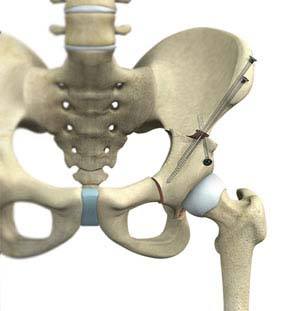Hip Preservation

Hip Preservation Surgery
The hip is a ball and socket joint comprising of the femur (thigh bone) and the pelvic bone. The head of the femur (ball) articulates with a cavity (socket) called the acetabulum in the pelvic bone. To facilitate the smooth and frictionless movement of the hip joint, the articulating surfaces of the femur head and acetabulum are covered by spongy articular cartilage. Injury, wear-and-tear and certain diseases can result in the wearing away of the cartilage tissue, causing painful rubbing of bones. Hip replacement surgeries have long been the choice of treatment, where the damaged parts of the joint are removed and replaced with a prosthesis. However, in young active patients, the prostheses are highly prone to wear-and-tear, and the need for repeat surgery. Hip preservation is a surgery that overcomes the limitations of joint replacement.
Indications for Hip Preservation Surgery
Some of the conditions indicated for hip preservation surgery include:
- Femoroacetabular impingement (FAI): friction in the hip joint from abnormal bony irregularities
- Hip dislocation: head of the femur moves out of the socket
- Hip dysplasia: A congenital hip condition characterized by a shallow acetabulum
- Labral tear: tear or separation of the labrum, a cartilaginous ring that surrounds the socket and seals the hip joint
- Avascular necrosis: disrupted blood flow to the hip joint, causing the death of bone tissue
Procedure
Hip preservation surgery includes various techniques:
Periacetabular Osteotomy
Periacetabular osteotomy is a surgical procedure to treat hip dysplasia. This involves cutting the acetabulum from the pelvic bone and repositioning it with screws to allow for a better fit of the femoral head. The procedure reduces pain, restores function and prevents further deterioration of the hip joint, thereby increasing the life of the hip joint and postponing total hip replacement.
Surgical Hip Dislocation
Surgical hip dislocation is a surgical technique that involves the dislocation of the hip joint during surgery to facilitate easy access to the inside tissues of the hip joint. It helps your surgeon to clearly view and treat abnormalities present deep into the hip joint.
Femoral Osteotomy
An osteotomy is a surgical procedure that involves cutting and reshaping of a bone. The femur is cut at the end close to the hip joint and realigned so that it forms a normal angle. This improves the distribution of force placed on the joint and prevents wear-and-tear of the cartilage.
Hip Arthroscopy
Arthroscopy, also referred to as keyhole or minimally invasive surgery, is a procedure in which an arthroscope is inserted into a joint to check for any damage and repair it simultaneously. Hip arthroscopy is a surgical procedure performed through very small incisions to diagnose and treat various hip conditions.
The various hip preservation surgeries for severe hip pain and dysfunction in young and active patients have been found to be beneficial, and also avoid or delay the need for hip replacement surgery.
Related Topics:
- Mini-Posterior Hip Replacement
- Hip Arthroscopy - Supine Position
- Robotic Total Hip Replacement
- Posterior Hip Replacement
- Hip Fracture ORIF
- Correction of a Failed Hip Replacement
- Correction of a Painful Hip Replacement
- Correction of a Loose Hip Replacement
- Hip Fracture Surgery
- Ischiofemoral Impingement Decompression - Procedure
- Surgical Release of Iliopsoas Tendon
- Physical Therapy for Hip
- Hip Arthroscopy
- Total Hip Replacement
- Minimally Invasive Total Hip Replacement
- Direct Anterior Total Hip Arthroptasty
- Revision Hip Replacement
- Computer-assisted Hip Replacement
- Gluteus Medius Tear
- Hip Trauma Reconstruction
- Slipped Capital Femoral Epiphysis
- AMIC of the Hip
- BMAC of the Hip
- Computer-Navigated Total Hip Replacement
- Direct Superior Hip Replacement
- Hip Reconstruction






